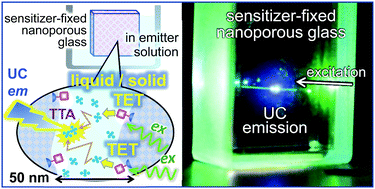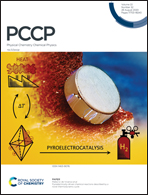Triplet–triplet annihilation upconversion through triplet energy transfer at a nanoporous solid–liquid interface†
Abstract
We report the triplet–triplet annihilation (TTA) upconversion (UC) through triplet energy transfer (TET) from a sensitiser fixed on a solid surface to free emitters dissolved in solution. A carboxylic-acid derivative of Pt–porphyrin was used as the sensitiser fixed on an amino-treated surface of continuous nanoporous glass without aggregation. UC emission was observed under photoexcitation of 532 nm for porphyrin-fixed glass immersed in an emitter solution of 9,10-diphenylanthracene (DPA), showing that TET occurs through the solid–liquid interface. The dynamics of TET was analysed through both phosphorescence decay of the sensitiser and UC emission rise from the emitter. Two TET components with different rate constants were found, slower than diffusion-controlled reactions in solution by 1–2 orders of magnitude. Nevertheless, the solid surface TET rates were fast enough to obtain a high quantum yield over the solid–liquid interface. By melting DPA and soaking it into sensitiser-fixed porous glass, we fabricated an all-solid system enabling TTA-UC through the bulk interface.



 Please wait while we load your content...
Please wait while we load your content...